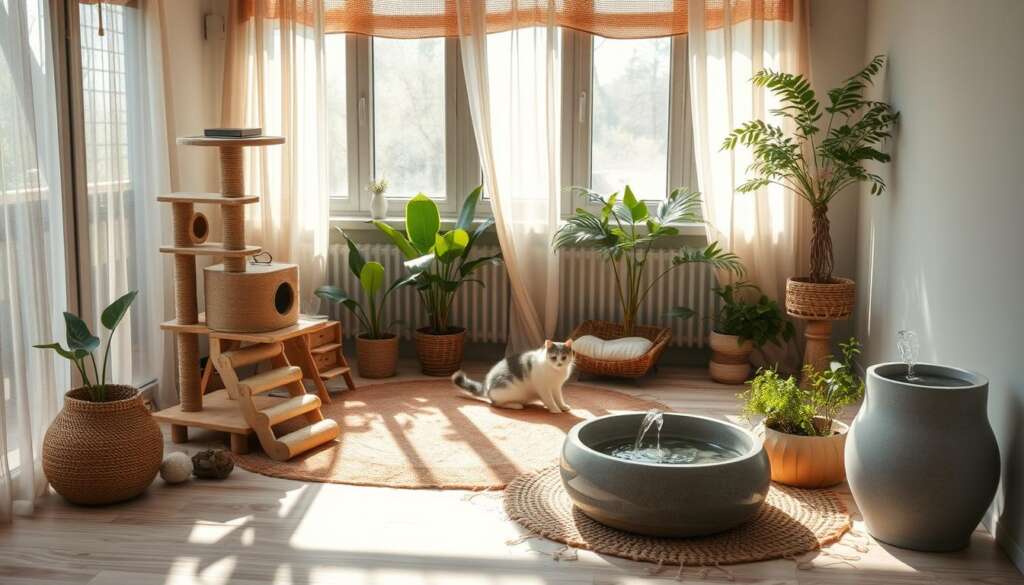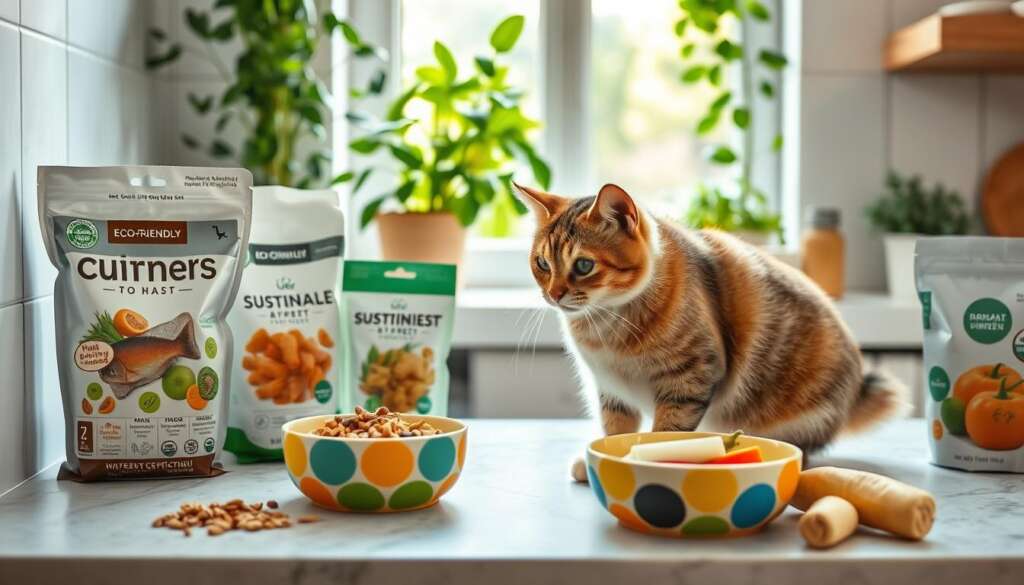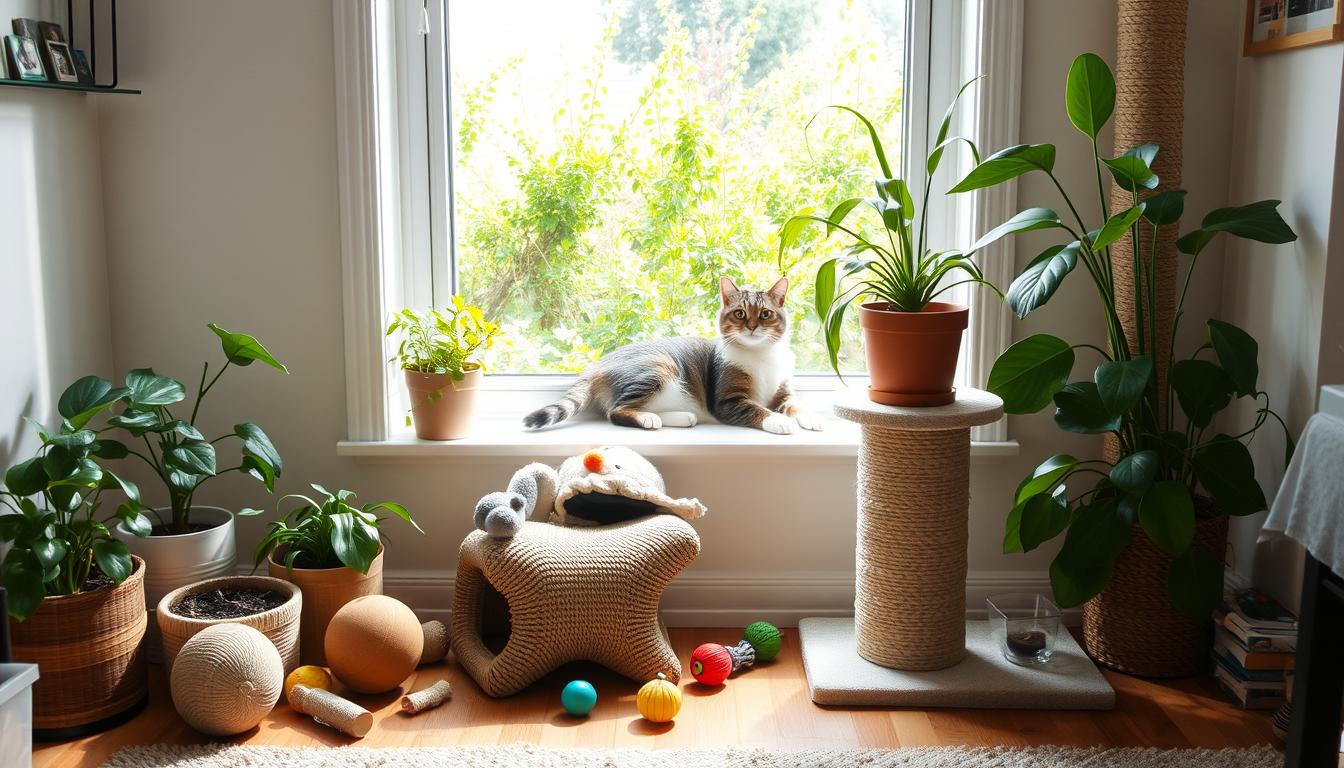Share This Article
Did you know your cat might have a bigger environmental impact than you think? With pet adoptions up more than 30 percent compared to 2019 last summer, it’s time to talk about sustainable pet ownership. Cats are not just cute friends but also part of a big ecosystem. So, what can we do to make their care more eco-friendly and reduce their environmental impact?
The pet food industry uses a lot of resources, with 25 percent of proteins in the U.S. going to it. Outdoor cats also harm billions of birds every year. But, there’s hope with brands like Purina and Hill’s Pet Nutrition working on greener packaging. Studies also show the harm some cat products can cause, like chemicals that hurt bees or unsustainable clay litters.
Brands like Omlet are making eco-friendly cat products, like 100% recyclable and compostable scratchers. They also offer natural litters to help reduce our pets’ carbon pawprints. As we move towards a greener future, we should think about all parts of our pets’ lives. This includes toys and food that are better for the planet.
As we dive into eco-friendly cat care, we must think about how to enjoy our pets while protecting the planet. In the next parts, we’ll look at ways to lessen our cats’ environmental impact. This way, our love for pets can help the earth. Let’s start our journey to sustainable pet ownership today.
Understanding Your Cat’s Environmental Impact
Many of us love the joy and companionship cats bring. But, we might not know about their big carbon footprint for pets. An average cat creates about 310 kg of CO2 emissions each year. This adds up to a big carbon pawprint.
This impact comes from their diet, pet accessories, and waste. It’s important to think about these things.

Cats also affect the environment in other ways. In the U.S., cat litter makes over two million tons of landfill waste every year. This waste is from non-biodegradable clay litter.
Choosing eco-friendly litter and trash bags can help. These choices can make a big difference in reducing waste.
What we feed our cats matters too. Choosing chicken or fish over beef can help the environment. It’s better for the planet.
Supporting brands that use sustainable materials is also key. They help lower our environmental footprint.
Cats also harm wildlife. In the U.S., cats kill between one to four billion birds every year. Keeping them indoors helps protect birds and other animals.
Understanding and minimizing pet environmental impact is vital. It helps protect our ecosystems and ensures a sustainable future. By choosing eco-friendly options for our pets, we help the planet.
Strategies for Sustainable Cat Care
Looking for eco-friendly cat care and a low-impact pet living lifestyle means making smart choices. These choices can greatly reduce your cat’s impact on the environment. From the food you give them to the products you use, every decision helps.
Choosing the right food is a big step towards being green. Organic cat food keeps your pet safe from harmful chemicals. Plus, buying food that’s locally sourced cuts down on carbon emissions.
Switching to eco-friendly cat litter is another big win. Regular clay litters harm the environment, but natural options like tofu or wheat are better. They’re good for your cat and the planet.

Playing with your cat in a green way is also important. Toys made from recycled or natural materials are safe and fun. They help reduce waste and support sustainable projects worldwide.
Properly getting rid of cat waste is key to a low-impact pet living lifestyle. Use biodegradable bags or a compost system to reduce landfill waste. Composting cat waste even helps with gardening.
Sharing ideas with other cat owners can make a big difference too. Talking about sustainable pet care with friends can inspire more people. Giving old pet items to shelters also helps reduce waste.
Eco-friendly cat care is more than just buying the right stuff. It’s about making sustainable choices in every part of pet care. By doing this, cat owners can make sure their pets are happy and the planet is protected.
Eco-Friendly Nutrition Habits for Felines
The pet food industry is changing fast. More eco-friendly food options for pets are coming out because people want to be green. Companies are making pet foods that are better for the planet. They use things like ostrich meat and plants instead of beef.
These eco-friendly food options for pets also make cats healthier. They add important nutrients from grains and veggies. This is good for both our planet and our pets.
Using recyclable packaging and less water is part of this change. It makes pet care better for the environment.
Pet owners can also make their own food at home. This lets you pick what goes into your pet’s meals. It’s natural and free from bad stuff. It also cuts down on waste from packaging.

When switching to green food, think about your cat’s diet. A vet can help make sure your cat gets what they need. This keeps your cat healthy and helps the planet.
Choosing eco-friendly food options for pets is good for both you and the planet. It’s a way to care for your pet and help the environment. By doing this, we can make a big difference for our pets and the world.
Reducing Your Cat’s Carbon Pawprint with Sustainable Accessories
In today’s world, it’s key to reduce the carbon footprint of pets, just like for humans. With 70 percent of U.S. homes having pets, their environmental impact is big. Using durable, reusable pet accessories made from bamboo, stainless steel, or recycled plastic helps a lot. These choices mean fewer replacements, less resource use, and less waste.
Traditional pet litters often harm the environment. But, options like wood shavings or paper pellets are better. They’re biodegradable and reduce waste. Using biodegradable waste bags for cat litter also helps prevent plastic pollution.
Every choice we make matters, from buying sustainable pet products to recycling toys. A 2017 study showed that meat for pet food is as bad as 13.6 million cars in the U.S. Switching to eco-friendly pet care can make a big difference. It’s not just about what we buy but also how we care for our pets. Proper waste disposal and spaying or neutering are important too.


